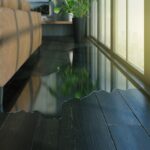What Is Hazard Insurance?

Your home is likely your most valuable personal asset — but unless you own it outright, your mortgage lender also has a financial stake in your investment. This is precisely why they require borrowers to take out a homeowners insurance policy, which protects the home from all kinds of covered events. Hazard insurance is the specific portion of your policy that covers your home’s physical structure.
The Insurance Information Institute reports that of all the homeowners insurance claims filed in 2018, 98.1 percent had to do with property damage. Numbers like these underscore just how important hazard insurance is. When all is said and done, it can help homeowners repair or rebuild their home if they’re faced with the unexpected.
Is Hazard Insurance the Same as a Homeowners Policy?
While the two terms are often used interchangeably, hazard insurance is not the same thing as homeowners insurance. The latter is an overarching form of coverage that offers a wide array of protections — including hazard insurance, which extends to your physical dwelling only. Beyond that, a standard homeowners insurance policy will also offer the following:
Personal property coverage: This portion of your policy will help you replace items in your home that are damaged or lost during a covered event. This typically includes electronics, clothing, jewelry, and furniture, among other things.
Liability coverage: If an accident occurs on your property and someone is injured, liability coverage can cover some or all of their legal and medical fees. Liability coverage can also apply to damage you cause to someone else’s property; for example, your child accidentally breaking a neighbor’s window.
Additional living expenses: If a covered event leaves you temporarily unable to live in your home, this portion of your homeowners insurance policy can take care of some of your living expenses. This generally includes expenses related to lodging and food.
Apart from the three coverage types outlined above, hazard insurance is all about your home’s physical structure. It’s called “hazard” insurance because covered events generally include a variety of threats. This usually includes damage caused by weather events like lightning, hail, and hurricanes. Fires and burglaries are likely covered too.
How Does Hazard Insurance Work?
Again, hazard insurance isn’t a separate policy. Instead, it’s folded into your standard homeowners insurance policy. You keep your hazard insurance active by paying your premiums. If your home’s structure is damaged or destroyed, you would file a claim with your insurance carrier. They will then determine if it was caused by a covered event.
If so, you’ll first have to meet your deductible before your coverage kicks in. This is the amount you’ll pay out of pocket each time you file a claim. Once you pay up to this amount, your insurer will cover the rest. You can usually get a lower deductible in exchange for a higher premium (and vice versa). Either way, it’s wise to have your deductible amount on hand in an emergency fund in the event you need to file a claim.
What Does Hazard Insurance Not Cover?
Your homeowners insurance policy should outline what’s covered. As mentioned earlier, fires, burglaries and certain weather events are usually on the table. However, there are some situations that aren’t protected by hazard insurance.
If your home’s structure is damaged or destroyed by a flood or earthquake, for example, a standard homeowners insurance policy won’t cover it. Instead, you’ll likely have to purchase additional coverage for these events. Similarly, damage caused by a sewage backup, burst pipe, or certain natural disasters may or may not be covered. Any damage that occurs due to regular wear and tear is often excluded. Sinkholes and landslides, which typically aren’t protected by hazard insurance, present other complications.
What’s more, it isn’t guaranteed that additional structures on your property, like a shed, gazebo or external garage, will be covered. Check your policy to better understand your protections.
How Much Does Hazard Insurance Cost?
Since hazard insurance isn’t purchased as a separate policy, the cost will be rolled into your general homeowners policy. Calculating your homeowners insurance cost will depend on many different factors. The following details can all shape your premium:
- Your home’s age
- Where you live
- Your deductible
- The level of your coverage
- Whether or not you’ve filed previous insurance claims
There are a lot of moving parts to consider. With that said, it isn’t uncommon to pay roughly $1,200 annually for homeowners insurance. At Matic, we take the headache out of finding the right policy and coverage level. Get a personalized quote today that’s based on your unique needs.



